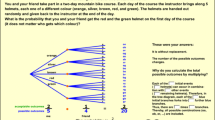Abstract
The purpose of this case study was to determine the effectiveness of using visual prompts with a model, lead, and test technique paired with a fading procedure. This was implemented to teach a student how to appropriately answer “Where are you?” The participant in this study was a 13-year-old boy, with low functioning autism who was also echolalic. This study took place in the participant’s self-contained special education classroom and at nine various locations at his school. The participant was taught to answer correctly when prompted to nine different places throughout his school. The participant was able to maintain this skill, when visual prompts were systematically reduced during the fading and no longer provided during the two no prompts conditions. Other personnel in the school were very satisfied with the outcomes.

Similar content being viewed by others
References
Alberto, P., & Troutman, A. (2006). Applied behavior analysis for teachers 7th ed. Upper Saddle River, NJ: Pearson.
American Psychiatric Association. (1994). Diagnostic and statistical manual of mental disorders 4th ed. Washington, DC: APA.
Billingsley, F. F., & Romer, L. T. (1983). Where are the generalized outcomes: An examination of instructional objectives. Journal of the Association for the Persons with Severe Handicaps, 11, 176–181.
Delli Sante, A., McLaughlin, T. F., & Weber, K. P. (2001). The use and evaluation of a Direct Instruction flash card strategy on multiplication facts mastery with two students with ADHD. Journal of Precision Teaching and Celeration, 17, 268–75.
Earles, T. L., Carlson, J. K., & Bock, E. (1998). Instructional strategies to facilitate successful learning outcomes for students with autism. In R. L. Simpson, & B. S. Myles (Eds.), Educating Children and Youth With Autism (pp. 75–77). Austin, TX: Pro-Ed.
Engelmann, S., & Becker, W. C. (1982). Theory of instruction: Principles and applications. New York: Irvington.
Gast, T., & Wolery, M. (1987). Severe maladaptive behaviors. In M. Snell (Ed.) Systematic instruction for people with severe handicaps (3rd ed.) Columbus, OH: Merrill.
Heward, W. L. (2006). Teaching exceptional children: An introduction to special education. Upper Saddle River, NJ: Pearson.
Kazdin, A. E. (1982). Single case research designs: Methods for clinical and applied settings. New York: Oxford University Press.
Lignugaris-Kraft, B. (2004). Applying direct instruction principles to new content. In N. E. Marchand-Martella, T. A. Slocum, & R. Martella (Eds.) Introduction to Direct Instruction (pp. 280–303). Boston, MA: Pearson.
Lovaas, I. O. (1981). Teaching developmentally disabled children: The me book. Austin, TX: Pro-Ed.
Marchand-Martella, N. E., Slocum, T. A., & Martella, R. (2004). Introduction to direct instruction. Boston, MA: Pearson.
Morgan, D., & Jenson, W. L. (1988). Teaching behaviorally disordered students: Preferred practices. Columbus, OH; Merrill.
Nelson, C., & Snow-Huefner, D. (2003). Young children with autism: Judicial responses to Lovaas and discrete child training debate. Journal of Early Intervention, 26, 1–19.
Steed, S. E., & Lutzker, J. R. (1997). Using picture prompts to teach an adult with developmental disabilities to independently complete vocational tasks. Journal of Physical and Developmental Disabilities, 9, 117–133.
Steed, S. E., & Lutzker, J. R. (1998). Recorded auditory prompts: A strategy to increase independent prevocational tasks by mentally retarded adolescents. Behavior Modification, 23, 152–168.
Stokes, T., & Baer, D. M. (1977). An implicit technology of generalization. Journal of Applied Behavior Analysis, 10, 349–367.
Taber, T. A., Alberto, T. A., & Fredrick, L. D. (1998). Use of self-operated auditory prompts by workers with moderate mental retardation to transition independently through vocational tasks. Research in Developmental Disabilities, 19, 127–145.
Wacker, D. P., & Berg, W. K. (1983). The effects of picture prompts on the acquisition of complete vocational tasks by mentally retarded adolescents. Journal of Applied Behavior Analysis, 16, 417–433.
Watkins, C., & Slocum, T. A. (2004). The components of direct instruction. In N. E. Marchand-Martella, T. A. Slocum, & R. Martella, (Eds.) Introduction to direct instruction (pp. 28–65). Boston, MA: Pearson.
Acknowledgments
The authors would like to give special thanks to the faculty and staff Bryant Elementary School, for allowing us to work with this student. Preparation of this document was in partial fulfillment of the requirements for EDSE 465—Classroom Management and EDSE 410—Precision Teaching, each a component of the B.Ed. in Special Education at Gonzaga University, Spokane WA. Preparation of this manuscript by the first author was in partial fulfillment of the requirements for a Bachelor of Education Degree in Special Education from Gonzaga University, Spokane, WA.
Author information
Authors and Affiliations
Corresponding author
Rights and permissions
About this article
Cite this article
Peterson, L., McLaughlin, T.F., Weber, K.P. et al. The Effects of Model, Lead, and Test Technique with Visual Prompts Paired with a Fading Procedure to Teach “Where” to a 13-Year-Old Echolalic Boy with Autism. J Dev Phys Disabil 20, 31–39 (2008). https://doi.org/10.1007/s10882-007-9077-1
Received:
Accepted:
Published:
Issue Date:
DOI: https://doi.org/10.1007/s10882-007-9077-1




